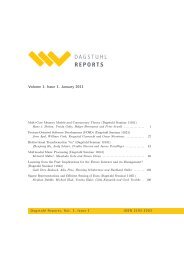Complete problems in the counting hierarchy - DROPS - Schloss ...
Complete problems in the counting hierarchy - DROPS - Schloss ...
Complete problems in the counting hierarchy - DROPS - Schloss ...
Create successful ePaper yourself
Turn your PDF publications into a flip-book with our unique Google optimized e-Paper software.
366 Monomials <strong>in</strong> arithmetic circuits<br />
Consider a multiplicatively disjo<strong>in</strong>t circuit C and a monomial m, where <strong>the</strong> <strong>in</strong>put gates<br />
of C are labeled ei<strong>the</strong>r by a variable or by −1. A parse tree T contributes to <strong>the</strong> monomial<br />
m <strong>in</strong> <strong>the</strong> output polynomial if, when comput<strong>in</strong>g <strong>the</strong> value of <strong>the</strong> tree, we get exactly <strong>the</strong><br />
powers <strong>in</strong> m; this contribution has coefficient +1 if <strong>the</strong> number of gates labeled −1 <strong>in</strong> T is<br />
even and it has coefficient −1 if this number is odd. The coefficient of m is thus equal to<br />
0 if and only if <strong>the</strong> number of trees contribut<strong>in</strong>g positively is equal to <strong>the</strong> number of trees<br />
contribut<strong>in</strong>g negatively.<br />
Let us represent a parse tree by a boolean word ¯ɛ, by <strong>in</strong>dicat<strong>in</strong>g which edges of C appear<br />
<strong>in</strong> <strong>the</strong> parse tree (<strong>the</strong> length N of <strong>the</strong> words is <strong>the</strong>refore <strong>the</strong> number of edges <strong>in</strong> C). Some of<br />
<strong>the</strong>se words will not represent a valid parse tree, but this can be tested <strong>in</strong> polynomial time.<br />
Consider <strong>the</strong> follow<strong>in</strong>g language L composed of triples (C, m, ɛ0¯ɛ) such that:<br />
1. ɛ0 = 0 and ¯ɛ encodes a valid parse tree of C which contribute positively to m,<br />
2. or ɛ0 = 1 and ¯ɛ does not encode a valid parse tree contribut<strong>in</strong>g negatively to m.<br />
Then <strong>the</strong> number of ¯ɛ such that (C, m, 0¯ɛ) belongs to L is <strong>the</strong> number of parse trees<br />
contribut<strong>in</strong>g positively to m and <strong>the</strong> number of ¯ɛ such that (C, m, 1¯ɛ) belongs to L is equal<br />
to 2 N m<strong>in</strong>us <strong>the</strong> number of parse trees contribut<strong>in</strong>g negatively to m. Thus, <strong>the</strong> number of<br />
ɛ0¯ɛ such that (C, m, ɛ0¯ɛ) ∈ L is equal to 2 N if and only if <strong>the</strong> number of trees contribut<strong>in</strong>g<br />
positively is equal to <strong>the</strong> number of trees contribut<strong>in</strong>g negatively, if and only if <strong>the</strong> coefficient<br />
of m is equal to 0 <strong>in</strong> C. Because L is <strong>in</strong> P, ZMC for multiplicatively disjo<strong>in</strong>t circuits is <strong>in</strong><br />
C=P. ◭<br />
◮ Theorem 3.2. ZMC belongs to coRP PP .<br />
Proof. Given a circuit C, a monomial m and a prime number p written <strong>in</strong> b<strong>in</strong>ary, CoeffSLP<br />
is <strong>the</strong> problem of comput<strong>in</strong>g modulo p <strong>the</strong> coefficient of <strong>the</strong> monomial m <strong>in</strong> <strong>the</strong> polynomial<br />
computed by C. It is shown <strong>in</strong> [16] (and implicitly <strong>in</strong> [22] and [17]) that CoeffSLP belongs<br />
to FP #P . See [9] for a more detailed proof simplify<strong>in</strong>g <strong>the</strong> one <strong>in</strong> [22].<br />
We now describe a randomized algorithm to decide ZMC. Let c be <strong>the</strong> constant given <strong>in</strong><br />
Lemma 2.5. Consider <strong>the</strong> follow<strong>in</strong>g algorithm to decide ZMC given a circuit C of size n and<br />
a monomial m, us<strong>in</strong>g CoeffSLP as an oracle. First choose uniformly at random an <strong>in</strong>teger<br />
p smaller than 2cn . If p is not prime, accept. O<strong>the</strong>rwise, compute <strong>the</strong> coefficient a of <strong>the</strong><br />
monomial m <strong>in</strong> C with <strong>the</strong> help of <strong>the</strong> oracle and accept if a ≡ 0 mod p. S<strong>in</strong>ce |a| ≤ 22n, Lemma 2.5 ensures that <strong>the</strong> above is a correct one-sided error probabilistic algorithm for<br />
ZMC. This yields ZMC ∈ coRP CoeffSLP . Hence ZMC ∈ coRP PP . ◭<br />
◮ Theorem 3.3. ZMC is coNP-complete both for monotone formulas and monotone circuits.<br />
Proof. For hardness, we reduce <strong>the</strong> NP-complete problem Exact-3-Cover [10] to <strong>the</strong><br />
complement of ZMC on monotone formulas, as done <strong>in</strong> [26, Chapter 3] (we reproduce <strong>the</strong><br />
argument here for completeness).<br />
Exact-3-Cover<br />
Input: Integer n and C1, . . . , Cm some 3-subsets of {1, . . . , n}.<br />
Problem: Decide if <strong>the</strong>re exists I ⊆ {1, . . . , m} such that {Ci | i ∈ I} is<br />
a partition of {1, . . . , n}.<br />
Consider <strong>the</strong> formula F = � m<br />
i=1<br />
(1 + �<br />
j∈Ci Xj). The monotone formula F has <strong>the</strong><br />
monomial � n<br />
i=1 Xi if and only if (n, C1, . . . , Cm) is a positive <strong>in</strong>stance of Exact-3-Cover.<br />
Let us now show that ZMC for monotone circuits is <strong>in</strong> coNP. This proof will use <strong>the</strong><br />
notion of parse tree types, which are <strong>in</strong>spired by <strong>the</strong> generic polynomial <strong>in</strong>troduced <strong>in</strong> [22]













